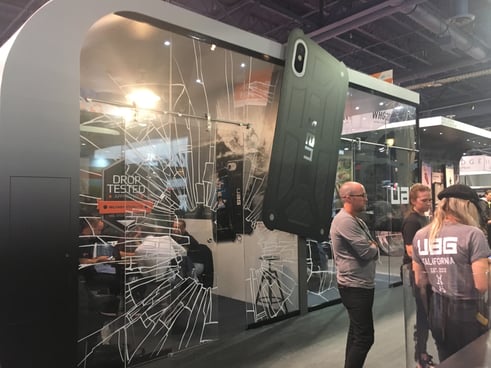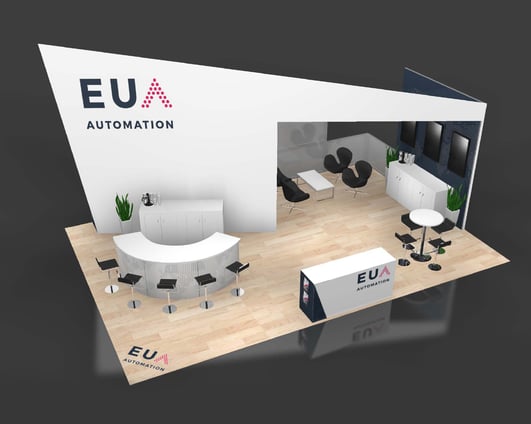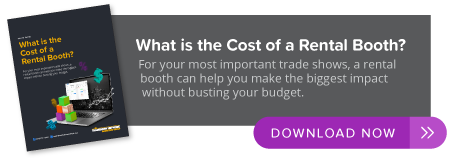For your most important trade shows, a rental booth can help you make the biggest impact without busting your budget. If you go to one or two shows a year where you use a larger-than-usual exhibit space, incorporating rental booth materials, rather than purchasing a custom exhibit that you will only use once or twice, may be your smartest choice. When considering your trade show budget, you have to take into account all expenses, not just the booth. While you may want to look as big as your competitor and get all your messages across to your market, your budget will likely be a limiting factor.
Figuring Return on Investment
How do you know how much you should spend on your rental booth? The overall cost of a trade show event can be overwhelming, so let’s work the math backwards.
First, look at how long it takes you to close a deal. If it takes three to six months, evaluate your expenses and potential income based on quarterly numbers. Let’s say your average profit on a sale is $5,000. Analyze your trade show expenses based on potential return on investment.
Using rough estimates for a trade show, the cost of reserving the booth space itself may run $12,000 for a 20x20 space. Then add on all the costs like travel, literature, and marketing, which may total another $8,000. So now you are up to $20,000 in expenses for a 20x20 space. On average, a 20x20 rental exhibit can cost between $18,000 and $30,000, which includes all major expenses such as shipping. If we use an average of $25,000, the total comes to $45,000 in your trade show budget for one show. These estimates assume that you are renting a booth every year, with expenses that can be written off annually. But if you are committed to trade shows as a viable lead stream, then you may want to consider the purchase of a custom booth, which will decrease your overall costs of participation in trade shows over time.
The question is: does this show produce the leads you need to generate at least ten deals ($50,000 in profits) in one year, in addition to having an ongoing impact for your business? If yes, then you know you are on the right track. If you think it generates more, then it may be time to look at a larger space with more show presence, thus driving more leads to your booth.
Once you have an idea of your budget and your exhibit needs, the next steps are to...
- Prioritize the shows and right-size the exhibit for each.
- Determine your booth space needs and functions.
- Evaluate rental options from the show organizer and exhibit firms.
- Know your show deadlines and plan in advance.
Rank the shows in your schedule from most important to least important and plan for a right-sized exhibit for each.
Start with the right show with the right prospects for your business. Not every show is equally important to reaching your best prospects. Consider where your largest competitors exhibit and how much of a splash they usually make. If you want to be considered a leader in your market, your presence at that show needs to be comparable to your top competitors. The largest companies usually invest in the largest booth spaces with custom exhibits that allow them to have several areas within their booth to serve a variety of purposes.
A new rental exhibit created for a specific show can help you make a custom-looking impact. However, you can also consider augmenting your regular custom booth with rental components. It can make economic sense to invest in a modular custom exhibit designed to expand with rental elements for one or more top-of- the-line shows.
Used exhibit materials are another option, since they can be refurbished to fit your color scheme and brand identity. Look for warehouse sales from exhibit design firms and even online listings of used trade show booths to get an idea of what is available.
Conversely, if you are looking to move into a new market, you may want to experiment with a starter rental booth. If it is a less-important show, you may begin with the smallest booth space and simply rent a skirted table and bring along pop-up graphics. That way, you can determine whether the show is worth a bigger investment next year. For smaller shows, you can save big money by using rental exhibits decorated with custom, brand-building graphics. The optimal booth space is typically a 10x20 foot environment with audio-visual capabilities, counters for displaying products and other amenities.
Depending on the size of the exhibit that you regularly use and ship cross-country, it can be less expensive and just as effective to rent the entire exhibit for certain shows. Rentals can be especially beneficial for international venues where shipping costs may be prohibitive. Plus, with a rental, you can determine all your display costs upfront because a full rental exhibit comes as a bundled package, including design, booth hardware, custom graphics, freight, set-up and dismantle.
Another budget-saving option is a rent-to-own contract on a custom booth. In order to own the display, the exhibitor agrees to rent the same exhibit three times over a period of three years or less. The rent-to-own exhibit comes with an array of services included, such as custom booth concept, build, graphic design, and storage. By dividing the payments over three years, a rent-to-own program permits the exhibitor to have a much lower upfront expenditure. Many companies have one big show a year, where they want to make a powerful impression, while their other shows call for smaller booths. The rent-to-own program suits their needs for a fresh, custom look and conserves their annual marketing budgets.
Determine how much space you need and how you are going to use your exhibit.
How you use your booth space depends on a number of factors, including the importance of the show to your marketing plan, the size of your budget, the image you want to convey, the business activities you want to conduct, and even the parameters of the event.
Some shows allow considerable latitude in what you can do in your exhibit space – everything from product demonstrations to food and beverage service to live entertainment. Other shows will not permit handouts of any kind.
For example, if you will be handing out product samples at only one or two shows, consider renting the display materials needed for that part of your exhibit. If you only need a private conference room for one show, rent it or incorporate refurbished booth materials.
Do your homework when signing up for new shows so that you know whether you can display your business to its best advantage.
Read the exhibitor manual months before the show and evaluate your rental options
The exhibitors guide helps you understand the rules of the trade show and what you can and cannot do with your booth space. The show organizer usually provides a number of rental options from official suppliers for the elements that you may not want to purchase and ship from show to show, such as carpet, tables, chairs, and lighting.
Keep in mind that the rental items offered by the show organizer will be limited and may not fit
the overall image you want to portray. If you are particular about how your booth looks, check out your options at independent exhibit design firms. For many rental items, you are not limited to just the suppliers recommended by the show organizer. It is equally important to reserve a high-traffic location. To do so, you may need to make your space reservation a full year in advance.
A helpful resource is the list of exhibitors that conference organizers typically provide. Depending on your marketing strategy, you may want to be close to exhibitors that are also prospects or far away from your largest competitors. It is best to apply for booth space in the corners, entryways, or other high-traffic areas. You want to see a steady flow of traffic by your booth. It is worth paying extra for a high-visibility space if it is a critical show.
Know your deadlines and plan in advance.
Many shows have long lead times for reserving space, and arranging for a high-end rental exhibit takes time. Waiting until the last minute to decide about your booth space and exhibit components may mean you are too late to get the best placement or that you will incur rush charges.
It is also important to plan ahead with marketing strategies to drive your best prospects to your booth and generate sales. Make sure the right employees will be available to work the booth, determine how you will interact with your prospects, get a display purchased or rented, and have the booth designed to match your advertising theme and brand image. It all takes time.
The same goes for handouts. Do not just cart in boxes of brochures. Most literature given out at trade shows is never read. You might want to create a simple one-page flyer with a promotion tied to that particular show or offer to send your literature via email or mail. Better yet, ask if you can deliver your brochure in person after the show and meet to discuss their needs in detail. Regardless, limit the amount of literature you hand out at shows and be prepared to interact with prospects and customers in your best light. This reminds us, do not forget the lighting. Rental light displays can help you really shine!






